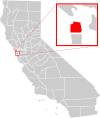Nob Hill, San Francisco
This article needs additional citations for verification. (February 2009) |
Nob Hill | |
|---|---|
 Nob Hill. | |
| Nickname(s): "Snob Hill", "Noob Hill", "Lower Nob Hill”, "Upper Nob Hill", "The Tender Nob", "Upper China Heights" | |
| Government | |
| • Board of Supervisors | David Chiu |
| • State Assembly | Tom Ammiano (D) |
| • State Senate | Mark Leno (D) |
| • U.S. House | Nancy Pelosi (D) |
| Area | |
| • Total | 1.02 km2 (0.395 sq mi) |
| • Land | 1.02 km2 (0.395 sq mi) |
| Population (2008) | |
| • Total | 20,671 |
| • Density | 20,230/km2 (52,390/sq mi) |
| [2] | |
| ZIP Code | 94108, 94109, 94133 |
| Area code | 415 |
Nob Hill refers to a neighborhood in San Francisco, California centered on the intersection of California and Powell streets. It is one of San Francisco's 44 hills, and one of its original "Seven Hills."
Location
The actual peak of Nob Hill lies slightly to the northwest, approximately at the intersection of Jones and Sacramento Streets. South of Nob Hill is the shopping district of Union Square, the Tenderloin neighborhood, and Market Street. To the east is San Francisco's Chinatown and a little farther, the city's financial district. Northeast of Nob Hill is North Beach and Telegraph Hill. North of Nob Hill is Russian Hill, and eventually, the tourist-centered areas of the waterfront such as Pier 39 and Fisherman's Wharf.
History
The area was settled in the rapid urbanization happening in the city in the late 19th century. Because of the views and its central position, it became an exclusive enclave of the rich and famous on the west coast who built large mansions in the neighborhood. This included prominent tycoons such as Leland Stanford, founder of Stanford University and other members of The Big Four. The neighborhood was completely destroyed in the 1906 earthquake and fire, except for the granite wall that had surrounded the Stanford and Hopkins mansions. The mansion of tycoon James Flood, though gutted by fire, was rebuilt and stands to this day as the headquarters of the Pacific-Union Club. While the neighborhood was able to maintain its affluence following the quake, many of the rich rebuilt their mansions further west in Pacific Heights and Cow Hollow. Many of the hotels now in the area were built over the ruins of the former mansions. Since the 1990s, Chinatown to its east has been slowly expanding into the neighborhood, shifting its demographics to a more Chinese characteristic.
Attractions and characteristics
Nob Hill is an affluent district, home to many of the city's upper class families as well as a large young urban professional population, as well as a growing Chinese immigrant population from a slowly encroaching Chinatown to the east. Sometimes it is sarcastically referred to as Snob Hill (in fact, "nob" is a slang term meaning "wealthy and distinguished person", possibly influenced by the word "nabob", and thus similar in meaning to "snob").The intersection of California and Powell streets is the location of its four well-known and most expensive hotels: the Fairmont Hotel, the Intercontinental Mark Hopkins Hotel, the Stanford Court, and the Huntington Hotel. Interestingly, they represent also three names out of The Big Four (i.e. Stanford, Hopkins & Huntington). The Fairmont is also named for a San Francisco tycoon, James G. Fair.
Opposite the Fairmount Hotel and Pacific Union Club is Grace Cathedral one of the city's largest Cathedrals. A large Masonic Temple is also located across from the church.
Images
-
Looking down Nob Hill
-
By the Cable Car Museum
-
Nob Hill
-
Masonic Memorial Temple
-
Cable Car and a Lexus RX up Nob Hill
-
Nob Hill Theatre
-
An apartment building near Huntington Park
See also
- InterContinental Mark Hopkins San Francisco
- Russian Hill
- 49-Mile Scenic Drive
- List of San Francisco, California Hills
- "Nob Hill" is also a neighborhood in Northwest Portland, Oregon, also known as the Alphabet Historic District from its street-naming system. It has many historic Victorian and Craftsman homes dating to the 19th and early 20th centuries.
- "Nob Hill" is also a neighborhood in Albuquerque east of the University of New Mexico.
References
External links
- The Nob Hill Association
- The Chronicle's standing article about Nob Hill
- The Cable Car Museum site
- Nob Hill, San Francisco, 7x7's Best Neighborhoods 2010: Best for Families









